What is the pitch ahead pass in basketball
The pitch ahead pass consists of action that occurs when a player, particularly in the backcourt, throws the basketball ahead to another player, typically in the frontcourt and usually near one of the wings or corners.
Afterwards, the player that received the ball via the pitch ahead pass could take a jump shot if open, score at the rim, or possibly create playmaking assists for additional teammates.
When is the pitch ahead pass commonly executed
The pitch ahead pass is commonly executed during transition offense and more specifically within primary break when the offensive team has a potential numbers advantage (such as a 2-on-1) or within secondary break when the defensive team is not fully prepared to properly defend against the actions of the offensive team.
Why is the pitch ahead pass a potentially effective action
The pitch ahead pass is a potentially effective action because it could create quick, scoring opportunities for the offensive team while simultaneously diminishing or totally negating the potency of the defensive team.
Essentially, when a certain player, notably during transition offense, executes the pitch ahead pass, primarily from the backcourt into the frontcourt, this will typically lead to one of two scenarios for the defensive team while they are executing their transition defense.
In the first scenario, which is basically the offensive team’s primary break, most (or all) of the defenders are not able to stay in front of the ball and as a result, one or more offensive players are able to get ahead of the majority of those same defenders in the frontcourt.
When that occurs, the offensive team would be able to use the pitch ahead pass to quickly score via layups/dunks at the rim.
In the second scenario, which is basically the offensive team’s secondary break, all of the defensive team is able to sprint into the frontcourt and stay in front of the ball.
However, they are not able to fully contain the ball or they are not able to completely prevent the offensive team from getting quality shot attempts from the perimeter or near the basket.
For example, when the pitch ahead pass occurs, one of the defenders closest to the ball could possibly execute a poor defensive closeout and that could lead to a wide open three-point shot or potential dribble penetration towards the basket.
Also, if dribble penetration occurs, this will almost certainly result in a defensive breakdown and the offensive team would be able to generate a high quality shot at the basket or sometimes near the perimeter.
Furthermore, even if the defensive team is able to contain dribble penetration or discourage jump shots, the offensive team could still utilize the pitch ahead pass to flow into other tactics such as high low action for additional scoring opportunities.
Affiliate Disclosure: I may earn a commission on qualifying purchases made through the links below.
What are examples of pitch ahead passes within transition offense
Example 1
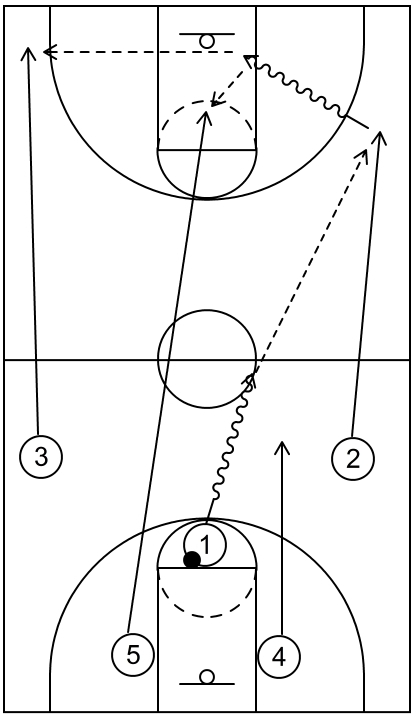
This is an example of a pitch ahead pass which could lead to scoring opportunities at the basket or from the perimeter. To start, 1 dribbles toward the half court line.
As that happens, 2 sprints to the right side wing, 3 sprints towards the left side corner, 5 runs to the rim, and 4 trails behind 1.
From there, 2 receives the ball from 1 via the pitch ahead pass. Next, 2 dribbles to the basket and scores via a layup/dunk.
However, if 2 was not able to score at the rim, then 5 could possibly receive the ball from 2 via a short pass and then score in the paint.
Moreover, 3 could potentially receive the ball from 2 via a drift pass and then take the three-point shot if open.
Example 2
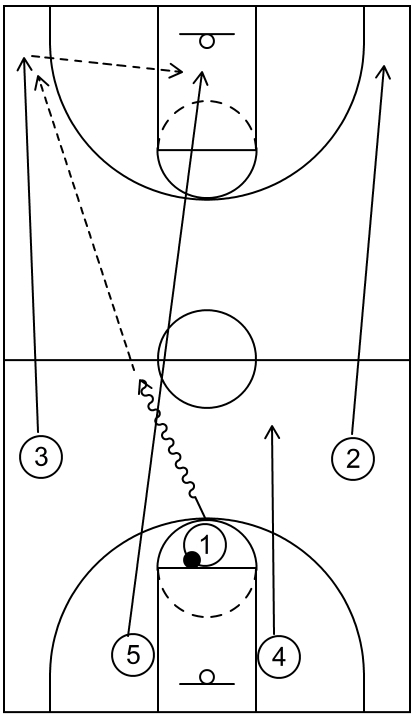
This is an example of a pitch ahead pass which could result in a score from the perimeter or near the basket. To begin, 1 dribbles toward the half court line.
As that occurs, 2 and 3 sprint to the corners, 5 runs to the rim, and 4 trails behind 1. Next, 3 receives the ball from 1 via the pitch ahead pass and following that, 3 could take the jump shot if open.
Alternatively, 5 could receive the ball from 3 and score in the paint via a layup/dunk.
Example 3

This is an example of a pitch ahead pass which could lead to a quick scoring opportunity near the basket. To start, 1 dribbles toward the half court line.
As that happens, 2 sprints to the right side wing area, 3 sprints to the basket, 5 runs to the high post, and 4 trails behind 1.
Afterwards, 3 receives the ball from 1 via the pitch ahead pass and then, 3 could score at the rim by way of a layup/dunk.
Example 4
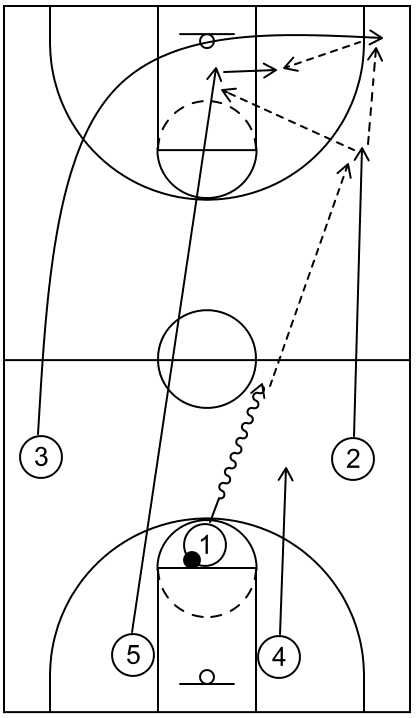
This is an example of a pitch ahead pass which could result in multiple scoring options. To demonstrate, 1 dribbles toward the half court line.
As that occurs, 2 sprints to the right side wing, 3 cuts through to the right side corner, 5 runs to the rim, and 4 trails behind 1.
Next, 2 could take the jump shot if open which also gives 5 an opportunity to get an offensive rebound if 2 misses the shot.
Furthermore, as another possibly scoring option, 5 could receive the ball from 2 and score at the basket.
Alternatively, 3 could receive the ball from 2 and take the jump shot if open. However, if the jump shot is not available, then 5 could cut to the right side low post block, receive the ball from 3, and then attempt to score with a low post move.
Example 5
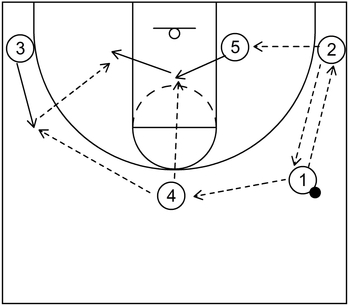
This is an example of the pitch ahead pass derived from Secrets of the North Carolina Secondary Break by Roy Williams.
To start, 2 receives the pitch ahead pass from 1. After that, 5 receives the post entry pass from 2 and then, 5 could possibly score with a low post move.
However, if 5 is not open to receive the ball, then 1 receives it again from 2. Next, 4 receives the ball from 1 and as that occurs, 5 cuts into the lane.
Following that, 5 could receive the ball from 4 to accomplish the high low action and afterwards, 5 could attempt to score quickly near the basket.
On the other hand, if 5 is not open to receive the ball, then 3 could cut to the wing and receive the ball from 4 to complete the ball reversal action.
As that occurs, 5 could cut through to the left side low post block and receive the ball from 3. From there, 5 could attempt to score near the rim again with a low post move.
What is an example of a pitch ahead pass basketball drill for transition offense
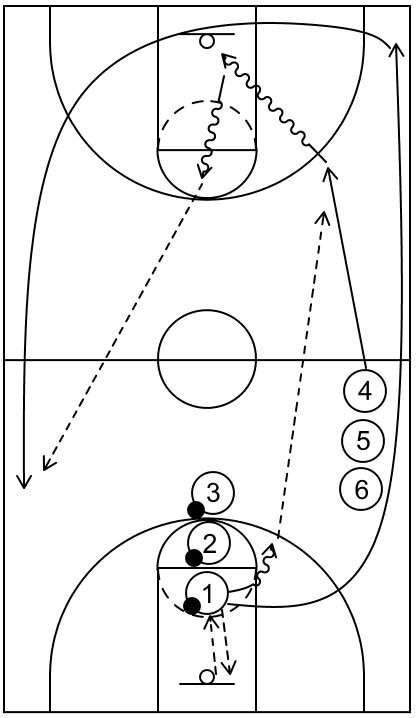
This is an example of a pitch ahead pass drill derived from All Access North Carolina Basketball Practice with Roy Williams.
To set up the drill, two lines are formed. One of the lines consists of players in the backcourt parallel to mid-court facing the frontcourt basket. The other line comprises players in the backcourt adjacent to the half court and sideline.
It should also be noted that the players’ numbers, in this case, are not representative of standard basketball positions. Therefore, player 1 does not necessarily have to be a point guard or player 5 does not necessarily have to be a center.
The numbers, in this example, are simply for demonstration purposes and to hopefully, make the information easier to understand.
To start the drill, 1 throws the ball off the nearest backboard and grabs it as if it was a missed shot by the opposing team. This is shown with the dotted arrows.
Moreover, upon receiving the rebound, 1 should also have elbows extended near the chin area to protect the ball.
As that occurs, 4 should sprint towards the opposite basket with a hand in the air calling for the ball. Afterwards, 1 should take one dribble towards 4 and from that point, 4 should receive the ball from 1 via the pitch ahead pass.
Next, 4 should only take one or two dribbles toward the basket and score at the rim via a layup/dunk. Furthermore, as that happens, 1 should also trail behind 4 near the right sideline and eventually loop under the frontcourt basket towards the opposite sideline.
From there, after 4 scores at the rim, 4 should get the ball out of the net. Following that, 4 should take no more than two dribble towards the nearest free throw line and then, 1 should receive the ball from 4 via the pitch ahead pass.
Afterwards, 1 would take no more than two dribbles towards the opposite basket and score at the rim while 4 trails behind. Once 1 and 4 complete the drill, they could either do it again or stay off the court near the sideline or baseline areas.
Next, 2 would execute the drill with 5 and then 3 would execute the drill with 6.